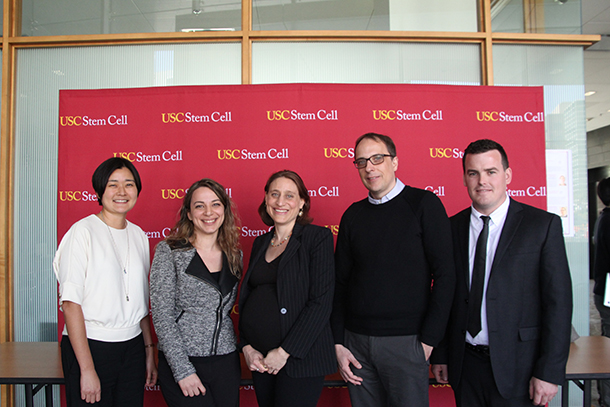Five next-generation scientists got everyone’s neurons firing at the Junior Faculty Candidate Mini-symposium, hosted by the Keck School of Medicine of USC Department of Stem Cell Biology and Regenerative Medicine on March 7.
Naomi Habib, PhD, from the Massachusetts Institute of Technology (MIT) and the Broad Institute posed a question with relevance to Alzheimer’s disease and other neurodegenerative conditions: “How can we apply natural regenerative processes to repair the brain?” She introduced her new tool for measuring the gene activity of brain cells, which she nicknamed “Single Nuclei RNA-seq,” or “sNuc-Seq.” She is using this and similar tools to identify diverse types of newborn brain cells, to follow their development and to understand their genetic characteristics in health and disease.
Mayssa H. Mokalled, PhD, from Duke University Medical Center also is studying a natural regenerative process: how adult zebrafish, unlike mammals, can repair a severed spinal cord. In zebrafish, she already has identified genes that promote the birth of new nerve cells and that stimulate cells to bridge across the injury site. Eventually, she hopes that the lessons learned from zebrafish will offer clues about how to encourage the mammalian spinal cord to regenerate after injury.
ChangHui Pak, PhD, from the Stanford University School of Medicine discussed mutations in various genes that might underpin intellectual disabilities, microcephaly and neuropsychiatric disorders such as autism and schizophrenia. To study this, she reprograms stem cells into neurons and uses gene editing to introduce mutations into these cells. She already has found key mutations that result in dysfunctional nerve connections, or synapses. She hopes to use her approach to study patient-derived neurons and the molecular mechanisms underlying these disorders in the near future.
Frank Soldner, MD, from the Whitehead Institute for Biomedical Research at MIT focused on a different neurological condition: Parkinson’s disease. Affecting 1 percent of the population aged 65 and older, Parkinson’s disease can cause rigidity, tremors, numbness and even dementia. Soldner reprograms skin cells from these patients into diseased neurons. He then studies the genetics and genetic regulators of these cells, and exposes the cells to drug-like compounds in search of effective therapies.
In a talk relevant to organs ranging from the brain to the lungs to the gut, Alex J. Hughes, PhD, from the University of California, San Francisco, shared his ambition “to build tissues like biology does.” As a first step, he is exploring a fundamental process in embryonic development: how a flat layer of cells folds into more complex shapes such as branches or folds. He described how a type of cell called a fibroblast can ingest the surrounding intercellular scaffold, creating a pulling force that can cause buckles, folds and other useful tissue shapes.
“I’d like to thank all the speakers for really spectacular talks,” said Andy McMahon, PhD, W.M. Keck Provost Professor of Stem Cell Biology and Regenerative Medicine and Biological Sciences; chair of Stem Cell Biology and Regenerative Medicine; and director, Eli and Edythe Broad Center for Regenerative Medicine and Stem Cell Research at USC. “It’s inspiring for all of us to interact with the next generation of scientists as they share their high-quality research.”
— Cristy Lytal


